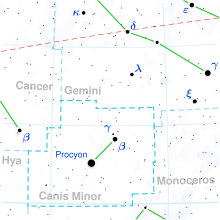Eta Canis Minoris
Binary star system in the constellation Canis Minor From Wikipedia, the free encyclopedia
Eta Canis Minoris (η CMi, η Canis Minoris) is a binary star[3] system in the equatorial constellation of Canis Minor. It is approximately 318 light-years from Earth.
| Observation data Epoch J2000.0 Equinox J2000.0 (ICRS) | |
|---|---|
| Constellation | Canis Minor |
| Right ascension | 07h 28m 02.07527s[1] |
| Declination | +06° 56′ 31.0897″[1] |
| Apparent magnitude (V) | 5.25[2] + 11.1[3] |
| Characteristics | |
| Spectral type | F0 III[3] |
| U−B color index | +0.17[2] |
| B−V color index | +0.22[2] |
| Astrometry | |
| Radial velocity (Rv) | +17.2[4] km/s |
| Proper motion (μ) | RA: −2.955 ± 0.231[5] mas/yr Dec.: −43.624 ± 0.197[5] mas/yr |
| Parallax (π) | 10.2691±0.1452 mas[5] |
| Distance | 318 ± 4 ly (97 ± 1 pc) |
| Absolute magnitude (MV) | 0.1[6] |
| Details | |
| η CMi A | |
| Mass | 2.16[4] M☉ |
| Luminosity | 57.5[4] L☉ |
| Surface gravity (log g) | 3.66[7] cgs |
| Temperature | 7,505±66[4] K |
| Rotational velocity (v sin i) | 54[8] km/s |
| Age | 818[7] Myr |
| Other designations | |
| η CMi, 5 CMi, BD+07°1729, GC 9970, HD 58923, HIP 36265, HR 2851, SAO 115477, ADS 6101, CCDM 07280+0657[9] | |
| Database references | |
| SIMBAD | data |
The primary component, η Canis Minoris A, is a yellow-white F-type giant with an apparent magnitude of +5.24. Its companion, η Canis Minoris B, is an eleventh-magnitude star located 4 arcseconds from the primary, though is actually around 440 AU from the main star and takes around 5,000 years to orbit it.[10]
References
Wikiwand - on
Seamless Wikipedia browsing. On steroids.

